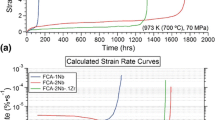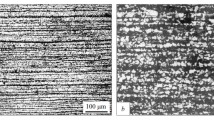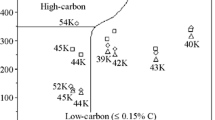Abstract
A study has been made of an Fe-3Ni-3Mo alloy whose structure can be either ferrite or martensite or any combination of ferrite plus martensite. By being able to measure the mechanical properties of the ferrite and martensite phases separately it is possible, using Milieko's theory for composites of two ductile phases, to calculate the properties expected for ferrite-plus-martensite mixtures. This theory assumes: 1) the stressstrain relationship for all structures is a power law; 2) a perfect interface between the phases; and 3) the fibers are aligned parallel to the stress axis. The experimentally determined tensile strength and ductility of the two-phase structures are in good agreement with the theory even though the martensite is not in the form of aligned fibers. The ductilities obtained at tensile strengths greater than 620 MPA (90 ksi) are no better than those for conventional HSLA steels because of the low ductility of the ferrite and low strength of the martensite.
Similar content being viewed by others
References
S. Hayami and T. FaruRawa:Proceedings Microalloying Conference, pp. 78- 87, Washington, D.C., 1975.
M. S. Rashid: SAE Preprint 760206, February, 1976.
J. H. Bucher and E. G. Hamburg: SAE Preprint 770164, February, 1977.
R. G. Davies:Met. Trans. A, 1978, vol. 9A, pp. 41–52.
R. G. Davies:Met. Trans., in press.
S. T. Mileiko:J. Mater. Sci., 1969, vol. 4, pp. 974–77.
G. Garmong and R. B. Thompson:Met. Trans., 1973, vol. 4, pp. 863–73.
A. J. McEvily, R. G. Davies, C. L. Magee, and T. L. Johnston:Transformation and Hardenability in Steels Symposium, pp. 179–91, Climax Molybdenum Corporation, Ann Arbor, Mich., 1967.
S. Floreen:Trans. TMS-AIME, 1966, vol. 236, pp. 1429–40.
W. B. Morrison:Trans. ASM, 1966, vol. 59, pp. 824–46.
See for example: J. D. Lubahn and R. P. Folgar:Plasticity & Creep of Metals, p. 113, J. Wiley & Sons, Inc., New York, N.Y. 1961.
W. P. Rees, B. E. Hopkins, and H. R. Tipler:J. Iron Steel Inst., 1954, vol. 177, pp. 93–110.
W. C. Leslie and R. J. Sober:Trans. ASM, 1967, vol. 60, pp. 459–84.
A. Kelly and W. R. Tyson:Proc. 2nd Berkeley Conf. on High Strength Materials, V. F. Zackay, ed., pp. 578–99, J. Wiley & Sons, Inc., New York, N.Y., 1964.
W. C. Leslie and R. J. Sober:Trans. ASM, 1967, vol. 60, pp. 99–111.
P. W. Bridgman:Studies in Large Plastic Flow & Fracture, Harvard Press, Cambridge, Mass., 1964.
Author information
Authors and Affiliations
Rights and permissions
About this article
Cite this article
Davies, R.G. The mechanical properties of zero- carbon ferrite-plus-martensite structures. Metall Trans A 9, 451–455 (1978). https://doi.org/10.1007/BF02646397
Received:
Issue Date:
DOI: https://doi.org/10.1007/BF02646397




